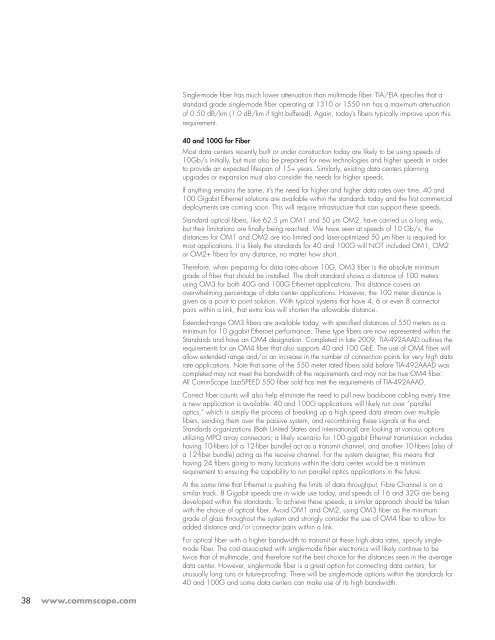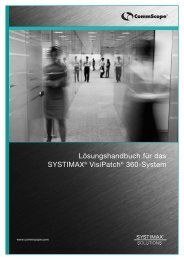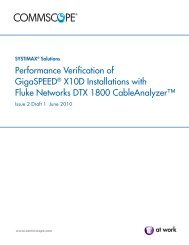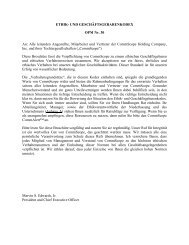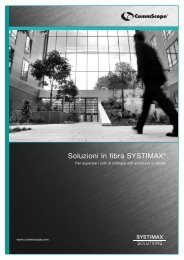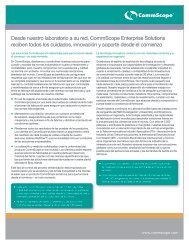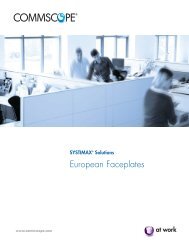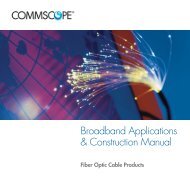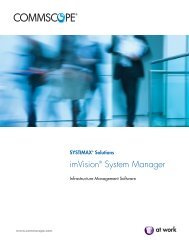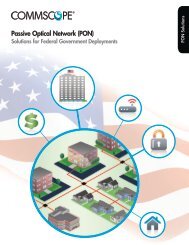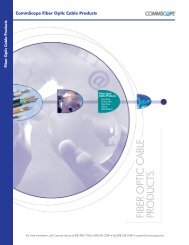CommScope® Enterprise Data Center Design Guide - Public ...
CommScope® Enterprise Data Center Design Guide - Public ...
CommScope® Enterprise Data Center Design Guide - Public ...
You also want an ePaper? Increase the reach of your titles
YUMPU automatically turns print PDFs into web optimized ePapers that Google loves.
38<br />
www.commscope.com<br />
Single-mode fiber has much lower attenuation than multimode fiber. TIA/EIA specifies that a<br />
standard grade single-mode fiber operating at 1310 or 1550 nm has a maximum attenuation<br />
of 0.50 dB/km (1.0 dB/km if tight buffered). Again, today’s fibers typically improve upon this<br />
requirement.<br />
40 and 100G for Fiber<br />
Most data centers recently built or under construction today are likely to be using speeds of<br />
10Gb/s initially, but must also be prepared for new technologies and higher speeds in order<br />
to provide an expected lifespan of 15+ years. Similarly, existing data centers planning<br />
upgrades or expansion must also consider the needs for higher speeds.<br />
If anything remains the same, it’s the need for higher and higher data rates over time. 40 and<br />
100 Gigabit Ethernet solutions are available within the standards today and the first commercial<br />
deployments are coming soon. This will require infrastructure that can support these speeds.<br />
Standard optical fibers, like 62.5 μm OM1 and 50 μm OM2, have carried us a long way,<br />
but their limitations are finally being reached. We have seen at speeds of 10 Gb/s, the<br />
distances for OM1 and OM2 are too limited and laser-optimized 50 μm fiber is required for<br />
most applications. It is likely the standards for 40 and 100G will NOT included OM1, OM2<br />
or OM2+ fibers for any distance, no matter how short.<br />
Therefore, when preparing for data rates above 10G, OM3 fiber is the absolute minimum<br />
grade of fiber that should be installed. The draft standard shows a distance of 100 meters<br />
using OM3 for both 40G and 100G Ethernet applications. This distance covers an<br />
overwhelming percentage of data center applications. However, the 100 meter distance is<br />
given as a point to point solution. With typical systems that have 4, 6 or even 8 connector<br />
pairs within a link, that extra loss will shorten the allowable distance.<br />
Extended-range OM3 fibers are available today, with specified distances of 550 meters as a<br />
minimum for 10 gigabit Ethernet performance. These type fibers are now represented within the<br />
Standards and have an OM4 designation. Completed in late 2009, TIA-492AAAD outlines the<br />
requirements for an OM4 fiber that also supports 40 and 100 GbE. The use of OM4 fiber will<br />
allow extended range and/or an increase in the number of connection points for very high data<br />
rate applications. Note that some of the 550 meter rated fibers sold before TIA-492AAAD was<br />
completed may not meet the bandwidth of the requirements and may not be true OM4 fiber.<br />
All CommScope LazrSPEED 550 fiber sold has met the requirements of TIA-492AAAD.<br />
Correct fiber counts will also help eliminate the need to pull new backbone cabling every time<br />
a new application is available. 40 and 100G applications will likely run over “parallel<br />
optics,” which is simply the process of breaking up a high speed data stream over multiple<br />
fibers, sending them over the passive system, and recombining these signals at the end.<br />
Standards organizations (Both United States and international) are looking at various options<br />
utilizing MPO array connectors; a likely scenario for 100 gigabit Ethernet transmission includes<br />
having 10-fibers (of a 12-fiber bundle) act as a transmit channel, and another 10-fibers (also of<br />
a 12-fiber bundle) acting as the receive channel. For the system designer, this means that<br />
having 24 fibers going to many locations within the data center would be a minimum<br />
requirement to ensuring the capability to run parallel optics applications in the future.<br />
At the same time that Ethernet is pushing the limits of data throughput, Fibre Channel is on a<br />
similar track. 8 Gigabit speeds are in wide use today, and speeds of 16 and 32G are being<br />
developed within the standards. To achieve these speeds, a similar approach should be taken<br />
with the choice of optical fiber. Avoid OM1 and OM2, using OM3 fiber as the minimum<br />
grade of glass throughout the system and strongly consider the use of OM4 fiber to allow for<br />
added distance and/or connector pairs within a link.<br />
For optical fiber with a higher bandwidth to transmit at these high data rates, specify singlemode<br />
fiber. The cost associated with single-mode fiber electronics will likely continue to be<br />
twice that of multimode, and therefore not the best choice for the distances seen in the average<br />
data center. However, single-mode fiber is a great option for connecting data centers, for<br />
unusually long runs or future-proofing. There will be single-mode options within the standards for<br />
40 and 100G and some data centers can make use of its high bandwidth.


